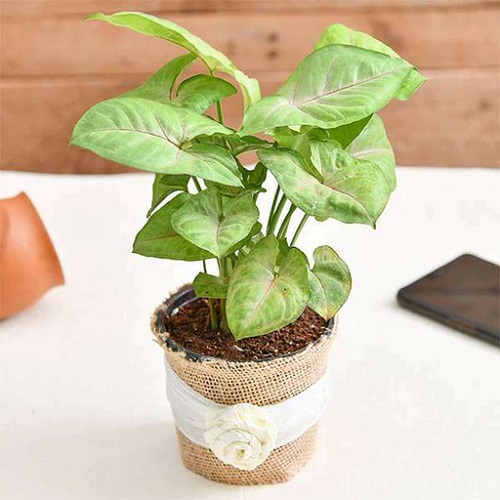Are you one of those who baffles between Caladiums and Syngoniums? Here’s a Caladium Vs. Syngonium guide to help you!
Caladiums and Syngoniums hail from the same family—Araceae, and share a close resemblance, making it harder to differentiate between the two. However, if you are doubtful that Are Caladium and Syngonium the Same? This Caladium Vs. Syngonium guide will help you!
Confused between Glacier Pothos and N’Joy Pothos? Click here
What are Caladiums?

Popular by the names—Heart of Jesus, Elephant Ear, and Angels Wings, Caladium is a tropical plant that boasts large, heart-shaped leaves beautifully patterned in shades of green, pink, white, and red. The leaves are typically glossy with a texture that adds depth and character to the plant’s appearance. The dynamic look of the foliage doubles under the rays of the sun, exuding a velvety sheen that is a sight to behold.
Standing at the height of 2-3 feet, the dark-hued stems contrast beautifully with the light colors wavy foliage, which in turn is highlighted by the prominent venation. The exceptional looks combined with easy-growing requirements make Caladiums a perfect fit for homes, cafes, and co-working spaces.
What are Syngoniums?

Popular as Arrowhead Vines and Goosefoot, Syngoniums are tropical perennials native to America that offer vibrant, lush green foliage. They are prized for their foliage, which comes in gradients of light to emerald green, showering a sense of greenery around the place. The veins on its foliage are intricately patterned, giving them a delicate, almost lace-like appearance.
Standing tall at 4-5 feet, the plant enjoys both bright and shady sun kisses. Syngoniums are often mistaken as shrubs due to their compact stature in the early years, but apparently grow as long woody vines as they mature and can liven any space with their tropical flare!
Are Caladium and Syngonium the Same?

The straight answer to Are Caladium and Syngonium the Same is—No. However, they share certain similarities on the grounds of appearance and care requirements.
- Both tropical beauties hail from the family of Araceae.
- They share a similar foliage pattern—heart-shaped variegated leaves with intricate venation.
- Both Caladium and Syngonium are toxic if ingested.
- Both plants thrive in damp environments. When they are young, they often require routine watering, which must be toned down as the plants mature.
Caladium Vs. Syngonium

Do not let their appearance confuse you! Learn about their differences below!
Leaf shape and pattern
- Caladium: Caladiums are shrubs with heart-shaped leaves that spread in width. These plants typically owe vivid and colorful leaves.
- Syngonium: It is a trailing or climbing plant which changes its foliage from a heart shape to a tri-lobed arrow. These exhibit shades of green.
Propagation
- Caladium: These are vascular plants that grow by means of tubers. They can be propagated by separating and cutting bulbs into smaller pieces, which produce baby Caladiums when planted in soil.
- Syngonium: These are non-vascular plants that grow by stem cutting. It can be propagated by cutting stems and roots through nodes or aerial roots.
Size
- Caladium: These are shorter plants with a maximum height of 2-3 feet. A single caladium is efficient at producing many babies around it.
- Syngonium: They are long vines and can be an invasive climber if left unattained.
Sun Exposure
- Caladium: Thrive best in bright partial shade and are sensitive to direct sunlight. Burnt leaf edges are a common trait in these houseplants if exposed to direct sunlight.
- Syngonium: On the other hand, Sungoniums are a little less sensitive to sunlight. However, long hours of intense sun exposure may lead to scorched foliage.
Habitat
- Caladium: These are vulnerable to low temperatures since they grow from tubers or bulbs. A minimum temperature of 70 F or 21 C is required to induce germination.
- Syngonium: Syngoniums can grow in temperatures as low as 60 F or 16 C.
Caladium Vs. Syngonium—Which is Easier to Grow?
Albeit both the beauties are easy growers, it is apparent from the foregoing explanation that Caladiums need a little more concern because they are more susceptible to environmental changes. Bright light can scorch their lovely foliage, and they don’t appreciate lower temperatures as well.
While Syngoniums are not very demanding, they can withstand short-term exposure to direct sun and can vine gracefully in unfavorable environmental conditions. Young syngoniums vines can easily be propagated in water.
To conclude—Syngoniums are comparatively easy to grow.






